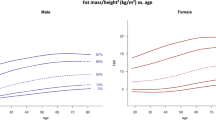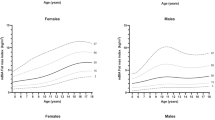Abstract
Background
Body composition parameters are linked to cardio-metabolic risk. However, high-quality reference values of body composition are scarce, particularly in Asian population. The aim of study was to construct sex- and age-specific normative reference values of body composition for the Vietnamese population.
Methods
This study was designed as a cross-sectional investigation that involved 2700 women and 1459 men aged between 20 and 90 (average 48, SD 15) who were participants in the population-based Vietnam Osteoporosis Study. Whole-body composition parameters (e.g., fat mass and lean mass) and site-specific (head, arms, trunk, and legs) parameters were measured by dual-energy X-ray absorptiometry (Hologic Horizon). Reference curves for each parameter and anatomical site were constructed using the Generalized Additive Model for Location Scale and Shape modeling technique.
Results
Overall, 8% of women and 11% of men were classified as obese (body mass index ≥ 27.5 kg/m2). Most fat mass was deposited at the trunk (~50%), followed by the leg (~33%). Women had ~10% more body fat (relative to body weight) than men. However, whole-body lean mass was higher in men than women, with the average difference being ~13 kg. Moreover, men had more bone mineral content than women (2110 vs. 1600 g). We also provided a comparison of age-related changes in body composition parameters between Vietnamese and US Whites.
Conclusion
These data provide gender- and age-specific reference values of body composition parameters for Vietnamese population. These normative values provide health professionals and the public with a resource for interpretation of body composition data.
This is a preview of subscription content, access via your institution
Access options
Subscribe to this journal
Receive 12 print issues and online access
$259.00 per year
only $21.58 per issue
Buy this article
- Purchase on Springer Link
- Instant access to full article PDF
Prices may be subject to local taxes which are calculated during checkout




Similar content being viewed by others
References
Lee DH, Giovannucci EL. Body composition and mortality in the general population: a review of epidemiologic studies. Exp Biol Med. 2018;243:1275–85.
Rolland Y, Gallini A, Cristini C, Schott AM, Blain H, Beauchet O, et al. Body-composition predictors of mortality in women aged ≥ 75 y: data from a large population-based cohort study with a 17-y follow-up. Am J Clin Nutr. 2014;100:1352–60.
Bray GA, Heisel WE, Afshin A, Jensen MD, Dietz WH, Long M, et al. The science of obesity management: an Endocrine Society Scientific Statement. Endocr Rev. 2018;39:79–132.
Gomez-Ambrosi J, Silva C, Galofre JC, Escalada J, Santos S, Millan D, et al. Body mass index classification misses subjects with increased cardiometabolic risk factors related to elevated adiposity. Int J Obes. 2012;36:286–94.
DeMarco VG, Aroor AR, Sowers JR. The pathophysiology of hypertension in patients with obesity. Nat Rev Endocrinol. 2014;10:364–76.
Misra D, Fielding RA, Felson DT, Niu J, Brown C, Nevitt M, et al. Risk of knee osteoarthritis with obesity, sarcopenic obesity, and sarcopenia. Arthritis Rheumatol. 2019;71:232–7.
Chen GC, Arthur R, Iyengar NM, Kamensky V, Xue X, Wassertheil-Smoller S, et al. Association between regional body fat and cardiovascular disease risk among postmenopausal women with normal body mass index. Eur Heart J. 2019;40:2849–55.
Ho-Pham LT, Lai TQ, Nguyen MT, Nguyen TV. Relationship between body mass index and percent body fat in Vietnamese: implications for the diagnosis of obesity. PLoS ONE. 2015;10:e0127198.
Pietrobelli A, Formica C, Wang Z, Heymsfield SB. Dual-energy X-ray absorptiometry body composition model: review of physical concepts. Am J Physiol. 1996;271:E941–51.
Wang J, Thornton JC, Russell M, Burastero S, Heymsfield S, Pierson RN Jr. Asians have lower body mass index (BMI) but higher percent body fat than do whites: comparisons of anthropometric measurements. Am J Clin Nutr. 1994;60:23–8.
Ho-Pham LT, Lai TQ, Nguyen ND, Barrett-Connor E, Nguyen TV. Similarity in percent body fat between white and Vietnamese women: implication for a universal definition of obesity. Obesity. 2010;18:1242–6.
Pham DD, Lee SK, Shin C, Kim NH, Eisman JA, Center JR, et al. Koreans do not have higher percent body fat than Australians: implication for the diagnosis of obesity in Asians. Obesity. 2019;27:1892–7.
Baim S, Leonard MB, Bianchi ML, Hans DB, Kalkwarf HJ, Langman CB, et al. Official positions of the International Society for Clinical Densitometry and executive summary of the 2007 ISCD Pediatric Position Development Conference. J Clin Densitom. 2008;11:6–21.
Shepherd JA, Baim S, Bilezikian JP, Schousboe JT. Executive summary of the 2013 International Society for Clinical Densitometry Position Development Conference on Body Composition. J Clin Densitom. 2013;16:489–95.
Kelly TL, Wilson KE, Heymsfield SB. Dual energy X-ray absorptiometry body composition reference values from NHANES. PLoS ONE. 2009;4:e7038.
Imboden MT, Swartz AM, Finch HW, Harber MP, Kaminsky LA. Reference standards for lean mass measures using GE dual energy x-ray absorptiometry in Caucasian adults. PLoS ONE. 2017;12:e0176161.
Ito H, Ohshima A, Ohto N, Ogasawara M, Tsuzuki M, Takao K, et al. Relation between body composition and age in healthy Japanese subjects. Eur J Clin Nutr. 2001;55:462–70.
Ho-Pham LT, Nguyen TV. The Vietnam osteoporosis study: rationale and design. Osteoporos Sarcopenia. 2017;3:90–7.
R Development Core Team. R: a language and environment for statistical computing. 2.7.0 ed. http://www.R-project.org. Vienna: R Foundation for Statistical Computing; 2008.
Stasinopoulos DM, Rigby RA. Generalized additive models for location scale and shape (GAMLSS) in R. J R Stat Soc C. 2005;54:507–54.
Cole TJ, Green PJ. Smoothing reference centile curves: the LMS method and penalized likelihood. Stat Med. 1992;11:1305–19.
Stasinopoulos DM, Rigby RA, Heller RF, Voudouris V, De Bastiani F. Flexible regression and smoothing using GAMLSS in R. CRC Press, Boca Raton, Florida; 2017.
Berman NG, Wong WK, Bhasin S, Ipp E. Applications of segmented regression models for biomedical studies. Am J Physiol. 1996;270:E723–32.
Muggeo VMR. segmented: an R package to fit regression models with broken-line relationships. R News. 2008;8:20–5.
Wilson JP, Kanaya AM, Fan B, Shepherd JA. Ratio of trunk to leg volume as a new body shape metric for diabetes and mortality. PLoS ONE. 2013;8:e68716.
Snijder MB, Dekker JM, Visser M, Bouter LM, Stehouwer CD, Yudkin JS, et al. Trunk fat and leg fat have independent and opposite associations with fasting and postload glucose levels: the Hoorn study. Diabetes Care. 2004;27:372–7.
Aasen G, Fagertun H, Halse J. Body composition analysis by dual X-ray absorptiometry: in vivo and in vitro comparison of three different fan-beam instruments. Scand J Clin Lab Invest. 2006;66:659–66.
Min KB, Min JY. Android and gynoid fat percentages and serum lipid levels in United States adults. Clin Endocrinol. 2015;82:377–87.
Santanasto AJ, Goodpaster BH, Kritchevsky SB, Miljkovic I, Satterfield S, Schwartz AV, et al. Body composition remodeling and mortality: the health aging and body composition study. J Gerontol A Biol Sci Med Sci. 2017;72:513–9.
Jackson AS, Stanforth PR, Gagnon J, Rankinen T, Leon AS, Rao DC, et al. The effect of sex, age and race on estimating percentage body fat from body mass index: The Heritage Family Study. Int J Obes Relat Metab Disord. 2002;26:789–96.
Womersley J. A comparison of the skinfold method with extent of ‘overweight’ and various weight-height relationships in the assessment of obesity. Br J Nutr. 1977;38:271–84.
O’Sullivan AJ. Does oestrogen allow women to store fat more efficiently? A biological advantage for fertility and gestation. Obes Rev. 2009;10:168–77.
Brown LM, Clegg DJ. Central effects of estradiol in the regulation of food intake, body weight, and adiposity. J Steroid Biochem Mol Biol. 2010;122:65–73.
Power ML, Schulkin J. Sex differences in fat storage, fat metabolism, and the health risks from obesity: possible evolutionary origins. Br J Nutr. 2008;99:931–40.
Ho-Pham LT, Lai TQ, Nguyen ND, Barrett-Connor E, Nguyen TV. Similarity in percent body fat between white and Vietnamese women: implication for a universal definition of obesity. Obesity. 2010;18:1242–6.
Consultation WHOE. Appropriate body-mass index for Asian populations and its implications for policy and intervention strategies. Lancet. 2004;363:157–63.
Acknowledgements
We sincerely thank MS Tran Thi Ngoc Trang and Fr Pham Ba Lam for coordinating the recruitment of participants. We also thank doctors and medical students of the Pham Ngoc Thach University of Medicine for the data collection and clinical measurements.
Funding
This research is funded by the Foundation for Science and Technology Development of Ton Duc Thang University (FOSTECT, http://fostect.tdt.edu.vn), Grant number FOSTECT.2014.BR.09, and a grant from the Department of Science and Technology of Ho Chi Minh City. The funders had no role in study design, data collection, and analysis, decision to publish, or preparation of the manuscript.
Author information
Authors and Affiliations
Contributions
Conceived and designed the experiments: TVN, LTHP, and HGN. Performed the experiments: TVN, LTHP, NVL, and KHND. Analyzed the data: HGN and TVN. Wrote the paper: HGN, LTHP, and TVN.
Corresponding author
Ethics declarations
Conflict of interest
The authors declare that they have no conflict of interest.
Additional information
Publisher’s note Springer Nature remains neutral with regard to jurisdictional claims in published maps and institutional affiliations.
Supplementary information
Rights and permissions
About this article
Cite this article
Nguyen, H.G., Le, N.V., Nguyen-Duong, K.H. et al. Reference values of body composition parameters for Vietnamese men and women. Eur J Clin Nutr 75, 1283–1290 (2021). https://doi.org/10.1038/s41430-020-00840-y
Received:
Revised:
Accepted:
Published:
Issue Date:
DOI: https://doi.org/10.1038/s41430-020-00840-y



